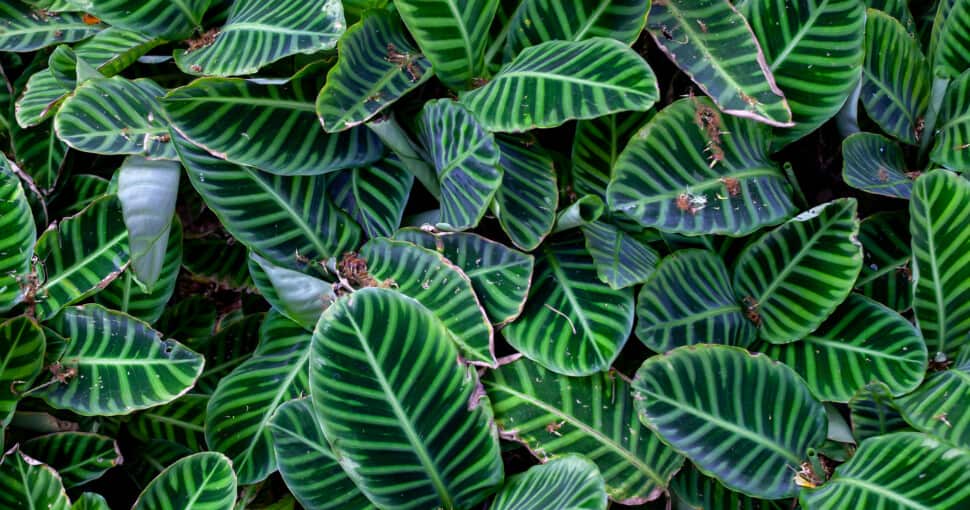Zebra plants are attractive plants to grow indoors or outdoors. They brighten up dark corners of offices or homes and offer an invitation to wander the cool shaded paths of a garden. Zebra plants have intriguing leaves that fold longitudinally as the sun goes down, earning them a spot in the list of prayer-plants.
Contents
Zebra plants (Calathea zebrina) are broad-leafed plants in the family Marantaceae that grow naturally in the tropical forests of Brazil and Africa.
They get their common name, zebra plants, from the striking coloring of their leaves. The leaves have alternating dark and lime-green stripes. The central leaf vein or midrib is white or yellowish green, adding to the visual luminosity of this plant.
The leaves are dark red on the lower surface, which can be seen when the plants fold up as the sun goes down.
There are numerous plants that look like zebra plants, allowing the gardener a wide choice of alternatives or complementary plants.
- Watermelon Peperomia
- Birkin Philodendron
- Inch Plant
- Green Velvet Alocasia
- Variegated Banana
- Variegated Cast Iron Plant
- Picasso Peace Lily
- Zebra Cactus
- Spider Plant
- Croton (Codiaeum variegatum)
1. Watermelon Peperomia
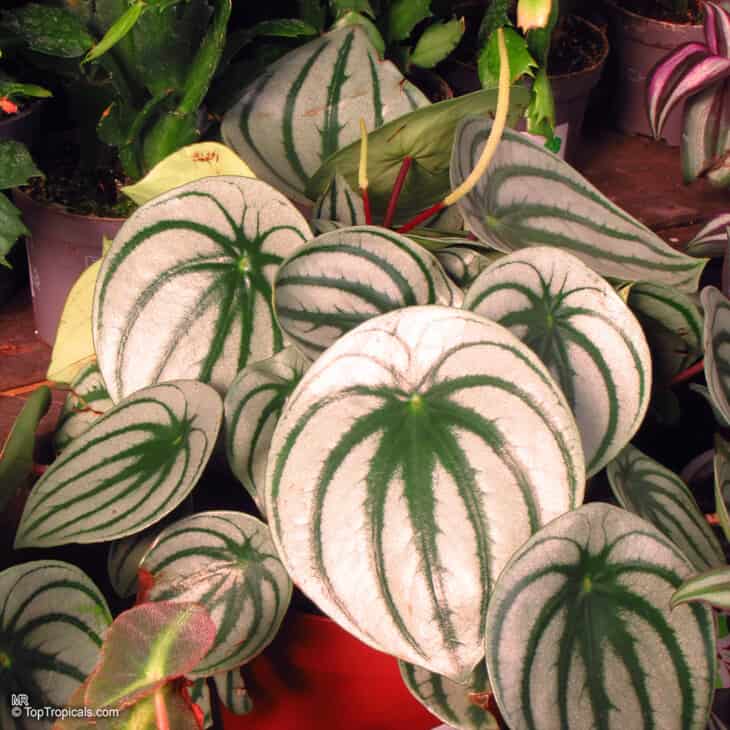
Watermelon peperomia (Peperomia argyreia), a native plant from South America, belongs to the family Piperaceae.
Like the zebra plant, watermelon peperomia has broad, striped leaves. The heart-shaped leaves of this peperomia have alternating green and silver bands, making them an attractive plant for indoor or outdoor use.
Watermelon peperomia is smaller than zebra plants, with an average size of twelve inches. There is a dwarf cultivar that only reaches six inches tall. A watermelon peperomia could be a good alternative if a zebra plant is too big for the available space.
2. Birkin Philodendron
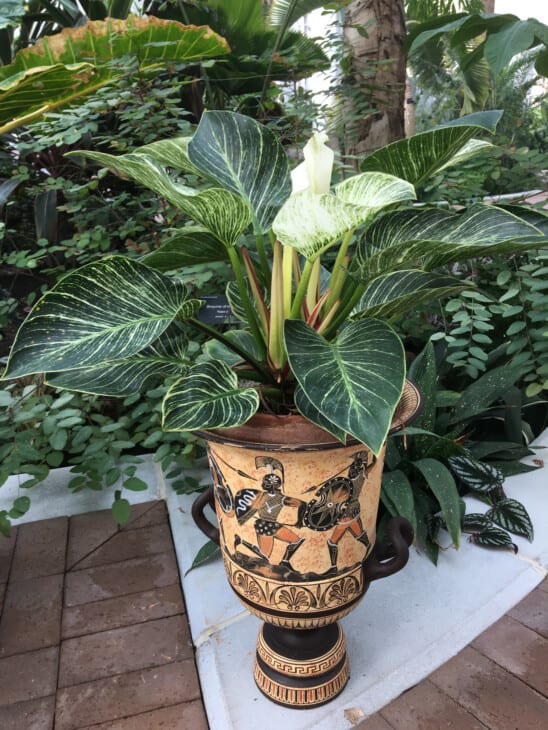
The Birkin philodendron is a mutation of the hybrid Philodendron Rojo Congo from the Araceae plant family. These are a species of plant that is native to Central America. Like zebra plants, they grow to about three feet tall.
Birkin philodendrons are different from other philodendrons as they are not climbers or creepers. These philodendrons have a thick upright stem. The teardrop-shaped leaves are green with yellow or white streaks that run from the midrib to the edge of the leaf.
They are easy plants to care for as long as they are grown in indirect or filtered light. They are excellent plants to grow in the bathroom as they flourish in the heat and higher humidity. Birkin Philodendron do not do well in dry climates or air-conditioned rooms.
3. Inch Plant
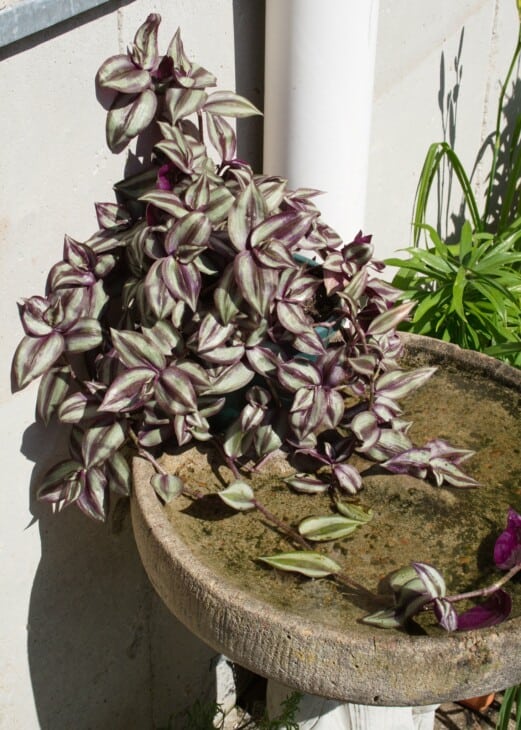
The inch plant (Tradescantia zebrina) is also sometimes known as the wandering Jew or wandering dude. Inch plants may also be called zebra plants in some circles.
Inch plants have purple, silver, and green stripes parallel to the midrib. The new growth is purple, and the older growth is green. In addition, there are two silver stripes at the outer edges of the leaf.
Like the other zebra plant, the inch plant has red undersides of the leaf. Inch plant leaves are much smaller than zebra plants and grow in thick clumps.
4. Green Velvet Alocasia
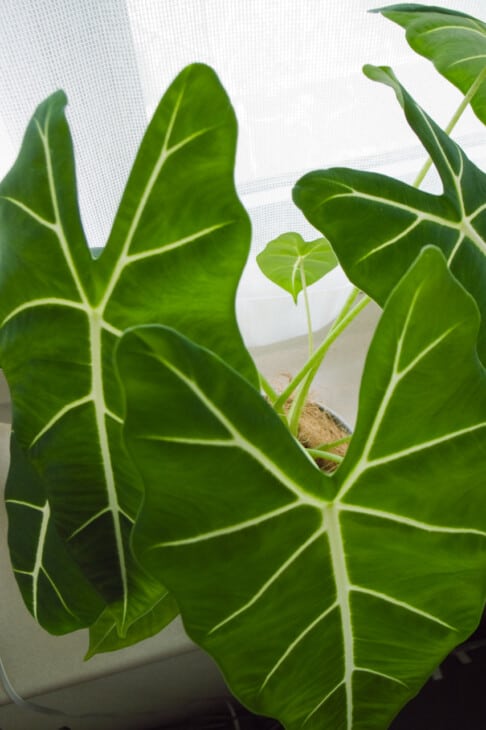
The green velvet alocasia is a hybrid of Alocasia amazonica. It is often called Elephant’s Ear plant because of the shape of the leaves. Although some gardeners say the leaves look like an elephant’s ears, some prefer to describe the leaves as shield-shaped.
The leaves are large, dark green, and velvety. They have white veins and midribs, which makes them similar to the zebra plant.
Green velvet alocasias are usually grown indoors. They can be grown outdoors if the right climatic conditions exist. These plants are native to South East Asia, so they do best in warm conditions with high humidity.
They are large plants and reach two to three feet, which is within the same range as zebra plants.
5. Variegated Banana
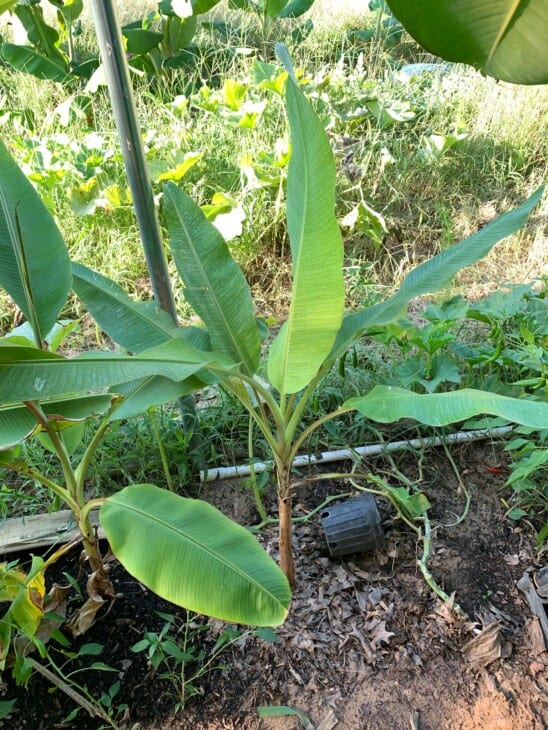
Bananas are synonymous with tropical islands and beaches, which is appropriate for variegated bananas (Musa x paradisiaca ‘Ae Ae’) as they originate in Hawaii. They belong to the Muscaceae family, the same family as regular bananas.
Variegated bananas have green and white striped leaves similar to zebra plants. Their leaves are much bigger than zebra plant leaves and make a strong visual impact wherever they are grown.
Like most banana trees, variegated bananas grow in hot, humid climates, making them unsuitable for areas with cold winters and cool summers. They can reach up to fifteen feet tall when planted outside, which is considerably larger than zebra plants. They are smaller when grown indoors.
6. Variegated Cast Iron Plant
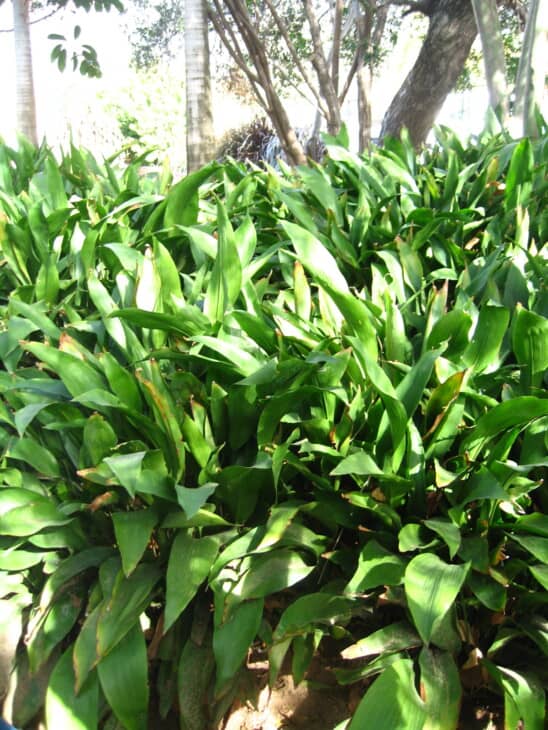
The variegated cast iron plant (Apidistra elatior ‘Okame’) is a very popular plant similar to zebra plants. It grows to just over two feet tall, so it is slightly smaller than zebra plants.
Variegated cast iron plants have intense green leaves with contrasting white stripes that run parallel to the midrib. They grow in deep shade outdoors and do well as indoor plants.
They are easy to maintain, making them a good alternative to zebra plants.
7. Picasso Peace Lily
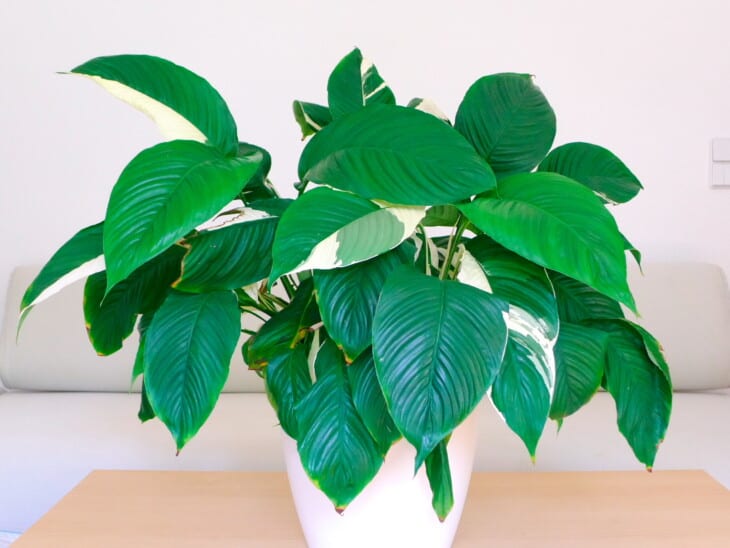
Picasso peace lily (Picasso Spathiphyllum) is an interesting plant that produces green leaves with white marks. Some leaves have large white portions, and others have thin lines resembling brush strokes.
The combination of brilliant green and white resembles zebra plants. They are popular for the white flower or spathe they produce.
Picasso lilies can be grown indoors or outdoors. They grow well in dappled shade or situations with two or three hours of sunshine daily.
8. Zebra Cactus
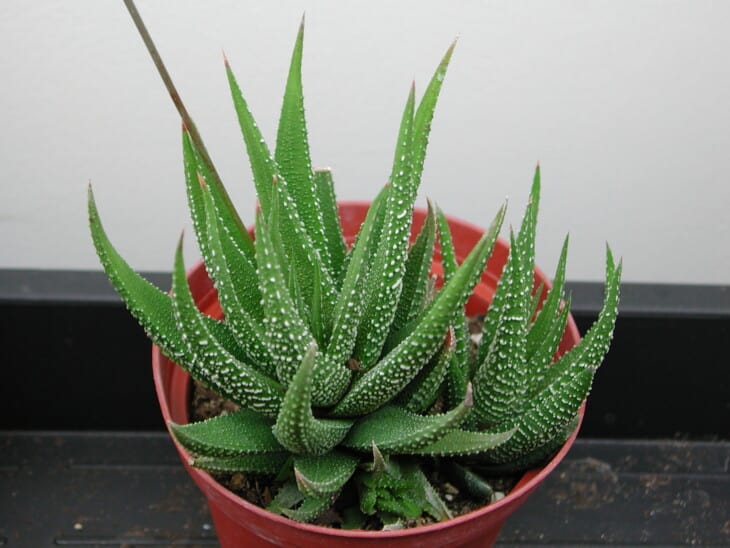
A zebra cactus (Haworthiopsis attenuate) is a good option for people who want the stripes of a zebra plant but cannot grow one in their climate. Zebra cacti are not a cactus at all. They are a succulent native to South Africa.
Zebra cacti, like all succulents, are adapted to growing in hot, dry conditions. Their leaves are red or green with horizontal white stripes. They may be grown indoors on a bright window sill but are best when planted in the garden.
Zebra cacti do not survive frost or temperatures below freezing. They need well-drained soil and will rot if the soil becomes waterlogged.
9. Spider Plant
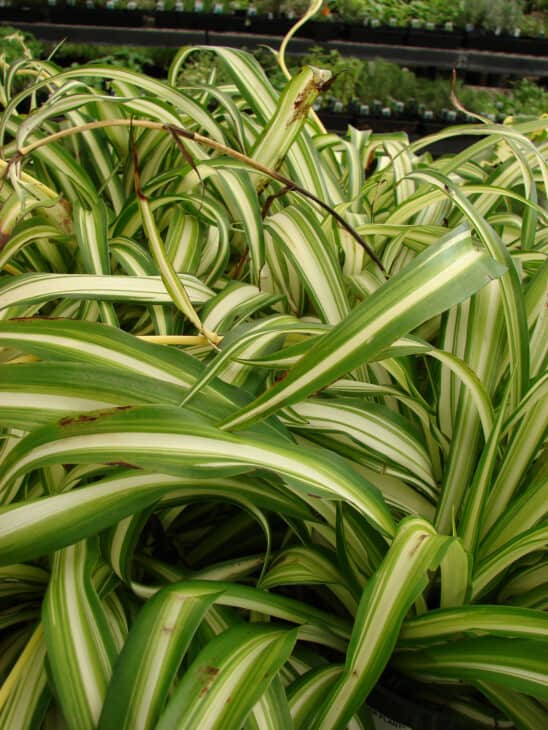
Chlorophytum comosum is known by the more user-friendly name of spider plants or hen and chicks plant. These plants belong to the family Asparagaceae and are indigenous to southern Africa. They have become naturalized in other countries with warm climates.
They have leaves with a white central region and green edges. Although their coloring resembles zebra plants, their leaves are thin and not broad like zebra plant leaves. There are a variety of spider plant species that can have different patterns on the leaves.
Spider plants are an easy plant to propagate. The parent plant produces offshoots which form new plants, explaining their other name, hen, and chicks. It is a simple matter to take one of the chicks (new offshoots) and plant it in a new pot or location in the garden.
10. Croton
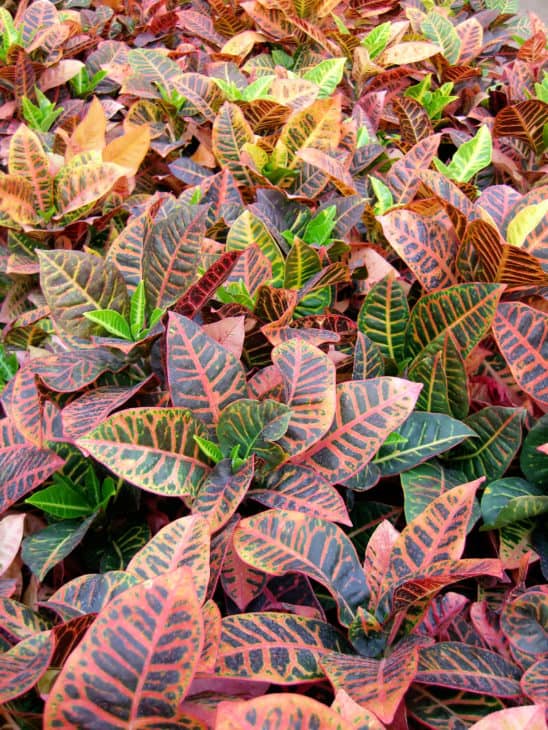
Crotons (Coediaeum variegatum) are plants cherished for their amazing foliage. They belong to the Euphorbia plant family that grows indigenously in Asia.
Wild crotons can grow as shrubs or small trees up to ten feet tall. When grown indoors, crotons are much smaller. They have broad leaves like zebra plants. Their thick leathery leaves can be two to twelve inches long.
Croton leaves can be red, yellow, purplish, or green, and some have stripes resembling a zebra plant. The leaf midrib is often a different color, and a contrasting color may highlight the leaf veins.
They need bright indirect light in hot climates or a few hours of sun in cool climates. They are good plants for dappled or partial shade.

